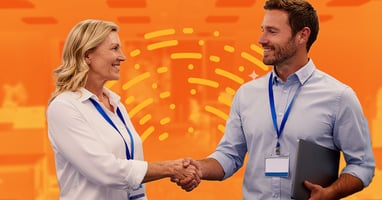We now live in a highly digitized world that's rapidly changing how we live, work, and get things done. For businesses, this means developing a secure, efficient, and progressive Information Technology (IT) strategy to keep pace with a rapidly changing technological environment.
Companies built on a robust technological foundation have an advantage. They are more agile, rapidly adapt to change, and consistently maintain a competitive advantage. They are also better placed to identify new business opportunities.
According to the State of IT report, companies are already scaling their use of AI, with 46% expecting to concentrate their efforts on the optimization of existing processes and systems and 44% expecting to leverage AI to drive innovation.
The key here is that organizations are investing in IT solutions and advancements that drive operational efficiency without losing flexibility. For example, enterprises are automating routine tasks while maintaining flexible processes. This approach allows teams to pivot as new opportunities or challenges arise.
However, the process isn't straightforward. Whether you're a startup, corporation, or public sector entity, the complexity of integrating the latest technologies and sustainable IT practices into your strategy requires expert guidance.
That's why many organizations turn to information technology strategy consulting firms with deep experience in digital transformation to help them create new technological capabilities and long-term sustainable value.
What is an IT Strategy?
An IT strategy is a well-documented plan outlining the organization's vision and mission for technology-driven initiatives to help it achieve its long- and short-term business goals.
Key components of an information technology strategy include the following:
- Alignment with business strategies
- IT governance
- Transition support
- Workflows and roles
Comprehensive IT strategies cover all technology (including hardware, software, and enterprise networks) and the people who manage them. The key here is to align IT resources with the company's broader goals by evaluating how AI, cloud computing, and cybersecurity innovations can enhance your operations, people, and processes.
As change is constant and business landscapes evolve rapidly, your IT strategic plan must be a road map that's flexible and adaptable. It should account for changing marketing conditions and emerging technology trends. It will also have to address how the road map can be implemented while ensuring business continuity.
Partnering with an IT strategy consulting firm won't be enough to implement a robust technology strategy. This is because you will need all stakeholders to buy into it. You must have the support of business leaders like the Chief Executive Officer (CEO) and IT leaders like the Chief Information Officer (CIO) and the Chief Technology Officer (CTO). You also need staff from general business units to get on board with your IT roadmap.
Why is an IT Strategy Important?
Although it's called an "IT strategy," it's not just about technology. It's about enabling and empowering the business. It's the go-to approach to ensure that current and future IT investments directly support the company's core mission and strategic priorities.
For example, if the enterprise aims to enhance customer experiences, your IT goals will concentrate on deploying highly user-friendly digital platforms supported by advanced data analytics.
How Do You Develop an IT Strategy?
Developing an IT strategy requires several carefully planned steps that ensure business alignment with technology initiatives and business goals. An IT strategic plan does more than just support day-to-day operations. It also helps businesses leverage cutting-edge technologies to maintain a competitive advantage and resilience.
Some key considerations include:
- Leveraging AI for automation and predictive insights: AI-driven analytics help companies anticipate market trends, changing customer demands, and operational efficiencies. Automation also helps companies quickly pivot and meet the evolving needs of the marketplace.
- Optimizing cloud and edge computing architectures: Hybrid cloud and edge solutions help ensure scalability, flexibility, and real-time data management and processing.
- Fostering agility: Work towards enhancing flexibility to adapt quickly to market shifts, customer expectations, and new technologies.
- Fortifying cybersecurity measures: Protect your organization against increasingly sophisticated cyber threats with robust, proactive security measures.
- Prioritizing sustainability: Adopt energy-efficient technologies and follow best practices to reduce the company's carbon footprint and meet environmental goals.
Here's a structured approach to creating and implementing an IT strategy:
Step 1: Analyze Current Processes and IT Infrastructure
The first step is to understand the current IT environment and the present state of business operations. It will help to conduct a SWOT Analysis to identify the company's strengths, weaknesses, opportunities, and threats.
It will also help to conduct a competitor analysis to understand the competitive landscape and where your organization is strategically positioned.
Step 2: Involve Stakeholders for a Holistic Approach
An effective IT strategy demands input from everyone in the organization. It's crucial to engage all stakeholders to benefit from diverse perspectives. This approach helps ensure that your plan addresses complex business needs.
Both external and internal stakeholders can help ensure the effective allocation of resources. IT teams can use their feedback as a benchmark to develop a framework on which all technology decisions can be based.
An IT strategic plan that actively involves everyone leverages collective knowledge to navigate the complexities of modern technology. Stakeholder engagement also helps foster a sense of ownership over the IT strategy, significantly improving your chances of company-wide buy-in and successful implementation.
Step 3: Define Strategic Objectives and Vision
It's critical to align IT objectives with strategic goals closely. To ensure that IT initiatives align with the company's mission and vision, create a vision statement outlining how IT will help the organization achieve its objectives.
Strategic objectives are specific, with measurable goals that help a business achieve its long-term mission and vision. These quantifiable, actionable, and time-bound strategic objectives will guide decision-making and drive progress.
To develop effective strategic objectives, you must first clearly define your goals. Then, create a purposeful statement with milestones on how you will move from the current state to the desired state. You can also break it down further into small actionable steps that are supported by regular assessments.
Your organization's vision statement must outline what it wants to become or achieve in the future. This helps businesses focus on strategic initiatives and technology investments using the overall company vision as a guide.
Your vision statement must be clear, concise, inspirational, and aligned with business strategies and goals. It should help closely align IT initiatives with business goals. An excellent example is Google's vision statement—to organize the world's information and make it universally accessible and useful.
Step 4: Assess Current Resources and Capabilities
To assess your current IT resources and IT capabilities, you have to start by evaluating the company's available assets, skills, and IT infrastructure. This approach helps us better understand the organization's strengths and weaknesses within the context of its strategic business objectives and vision.
To assess your current IT resources and IT capabilities, you must:
- Create an inventory of IT systems and assets (hardware, software, storage, and network infrastructure)
- Conduct a human resources assessment (identify available skills and expertise, staffing levels, and training needs)
- Evaluate current financial resources (conduct budget analysis and review the cost structure)
- Examine operational capabilities (evaluate IT processes, including incident management, change management, IT service desk operations, and service level agreements)
- Measure current technology and IT infrastructure capabilities (find out if your current IT infrastructure can scale to ensure sustainable growth, leverage technologies, ensure security, and align with industry standards)
This exercise will help businesses comprehensively understand their current resources and capabilities to implement a robust IT strategy.
Step 5: Create an Action Plan
Formulating an actionable plan requires several key steps, defining clear objectives that are Specific, Measurable, Achievable, Relevant, and Time-bound (SMART). As a rule, it's always best to prioritize tasks based on their expected impact and resource requirements. This is not always straightforward.
It will help to create a detailed, actionable IT roadmap by breaking down large IT projects into smaller tasks. In this scenario, it will help to follow the Work Breakdown Structure (WBS) project management approach.
IT operations teams should use available tools like Gantt charts or timelines to visualize project schedules and dependencies. You must clearly define milestones and deliverables for each stage and assign specific roles and responsibilities to IT operations team members.
You must also create a seamless communication plan to keep stakeholders in the loop. It's a good idea to use project management software to track progress and maintain clear communication among IT departments and various team members.
A budget and resource allocation plan must support the action plan to ensure the efficient use of resources. At this stage, it's critical to have a risk management strategy to mitigate potential risks as they arise.
Step 6: Implement the Strategy and Measure the Results
To put your detailed action plan to work, begin by executing each initiative according to the IT project plan. This can only work if all stakeholders understand their roles and responsibilities.
It's also crucial to allocate resources efficiently. This includes budget, technology, and talent to support each task. You should also be ready with a contingency plan when things don't go as expected.
Establishing key performance indicators (KPIs) that align with your strategic business objectives is critical. These metrics should provide a quantifiable way to assess progress regularly and provide opportunities to revise and realign.
This ongoing evaluation helps keep costs down by ensuring that your strategy remains aligned and continues to drive desired outcomes. Regular reviews and adjustments help businesses achieve their IT objectives and goals.
Staying Adaptable in a Fast-Changing Landscape
The iterative process of implementation and evaluation we discussed is critical to maintaining a competitive edge in a rapidly changing technological landscape. While planning is essential, overplanning can lead to rigidity, which is a barrier in a world with rapid technological and business shifts.
For example, your IT strategy must be adaptable to accommodate unexpected developments in AI, cybersecurity threats, cloud innovations, sustainability requirements, and market dynamics.
Businesses that do this successfully often focus on detailed planning for 18 to 24 months while keeping the following years flexible to embrace new opportunities and challenges.
In other words, it's important to keep your IT strategy relevant without becoming overly prescriptive.
Governance, Processes, and Organizational Structure
A successful IT strategy can only be built on a solid foundation in governance, processes, and organizational structure. So, while focusing on technology, you will also have to pay attention to compliance, ethics, security, and how to manage them efficiently.
Ideally, your processes should support enterprise architecture while also managing AI model lifecycles, cybersecurity threat intelligence, cloud cost optimization, sustainability metrics, edge device management, and continuous integration/continuous deployment (CI/CD) pipelines.
Partnering with Managed Services Providers (MSPs)
If you're working with IT strategy consulting services firms like Managed Services Providers (MSPs) with a proven track record, you can depend on their extensive expertise, access to the latest technology, and personnel to support your IT strategy.
They will also be well placed to make proactive suggestions to adopt the latest technology solutions early to stay ahead of the curve. Another benefit of partnering with an MSP is the fact that they make cloud migration and optimizing security measures an easy endeavor.
As technology evolves and continues to disrupt industries, outsourcing your IT needs to a technology management consulting firm plays a critical role in ensuring business growth, relevance, and, of course, business value.
It's important to adopt the right technologies to support your business model or operational model, involve stakeholders, stay adaptable, and establish robust governance and business processes. Whenever companies need help, partnering with the right MSP can help organizations thrive in an increasingly digital world.
Categories: Business Process Management, Managed Services, Strategy, Managed IT Services, IT Management, VCIO, Digital Transformation, Cybersecurity Assessment, IT Strategy Consulting, IT Strategy for Business, IT Consulting Services, IT Planning and Strategy, IT Strategy Framework for Companies, How to Develop an IT Strategy for Your Business, IT Roadmap for Business, IT Management Consulting, IT Infrastructure Planning, Technology Strategy Consulting











